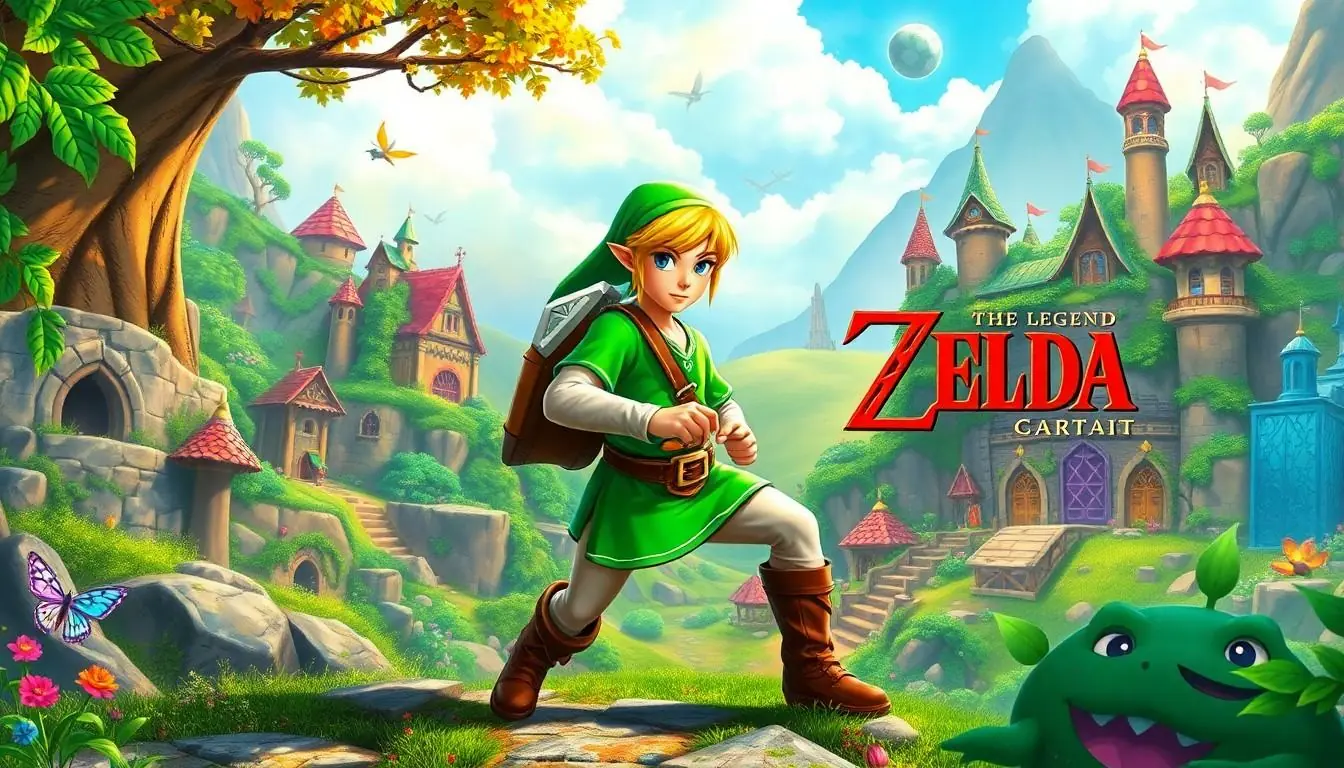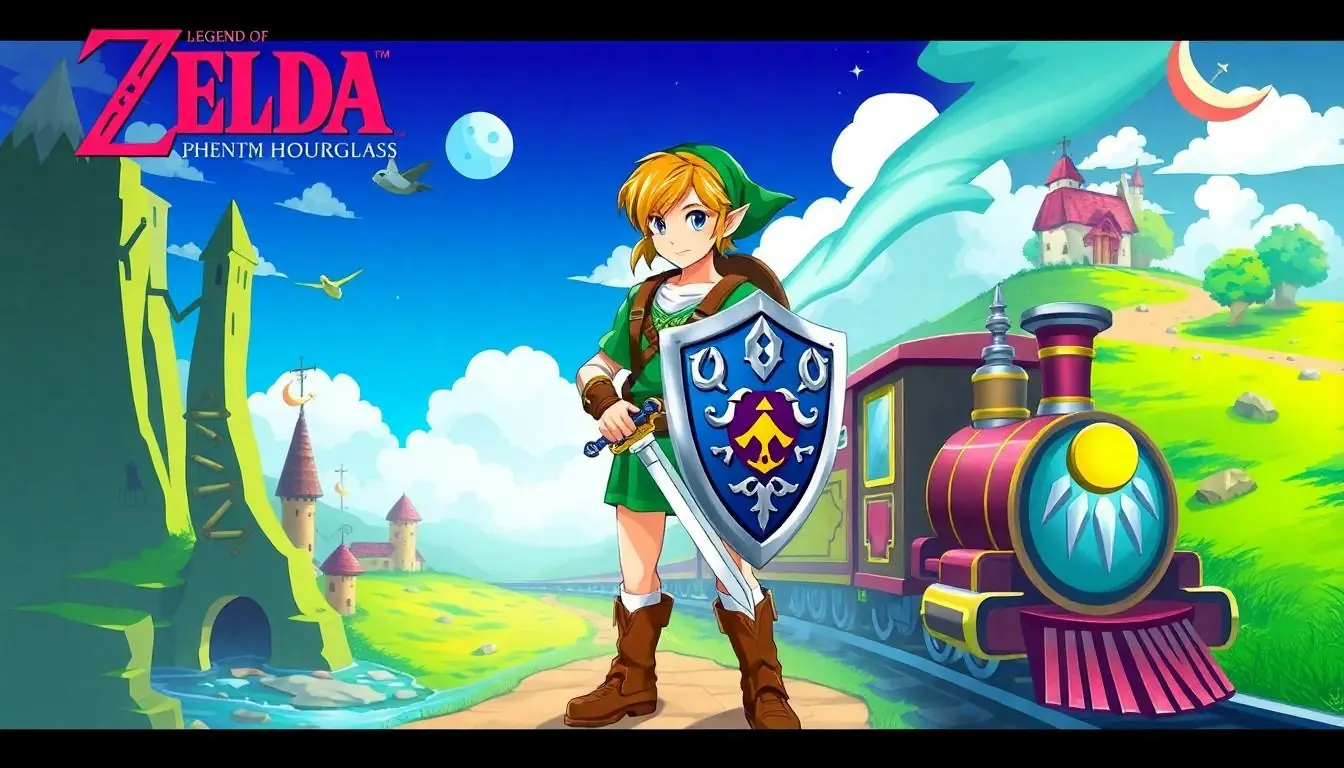In the vast kingdom of Hyrule, where swords clash and puzzles baffle even the sharpest minds, the Nintendo DS has birthed some of the most unforgettable adventures in the Legend of Zelda series. Gamers have wielded their styluses like swords, navigating dungeons and battling foes while trying to avoid the ever-looming threat of their handheld device running out of battery. But among these pixelated gems, one title stands out like a golden Triforce: the best DS Zelda game.
Table of Contents
ToggleOverview of the DS Zelda Series
The Nintendo DS series features two main titles: The Legend of Zelda: Phantom Hourglass and The Legend of Zelda: Spirit Tracks. Both games introduced innovative touch-screen mechanics that enhanced gameplay. Players could control Link’s movements, interact with objects, and solve puzzles using the stylus.
Phantom Hourglass builds on the spirit of traditional Zelda gameplay while incorporating elements designed for the DS system. It continues the story of The Wind Waker, with Link embarking on a quest to save Tetra. Exploration of the seas, dungeon navigation, and combat encounters provided a rich experience, appealing to both new and returning fans.
Spirit Tracks takes the adventure in another direction by introducing train travel. Players guided Link across a new land while completing quests and defeating foes. The incorporation of a new companion, Zelda, adds a fresh dynamic to the story. Dungeon mechanics emphasize cooperative gameplay, utilizing the stylus for puzzles and combat.
Graphics remain visually captivating in both titles, retaining the colorful art style characteristic of the series. Each game successfully blends exploration, puzzle-solving, and action, ensuring that players remain engaged throughout their journey. The overarching narrative connects well within the Zelda universe, providing depth and continuity.
Both titles have their strengths, but determining the best DS Zelda game involves considering gameplay mechanics, storyline depth, and overall player experience. Evaluating these factors will ultimately lead to a preference between the two games.
Best DS Zelda Game Options
The Nintendo DS hosts captivating titles in the Legend of Zelda series. Players experience unique mechanics and engaging stories in both of these games.
The Legend of Zelda: Phantom Hourglass
Phantom Hourglass follows Link on a quest to rescue Tetra, continuing from The Wind Waker. With its innovative use of the stylus, players navigate dungeons effortlessly. Fresh puzzles and intuitive combat encounters ensure a dynamic experience. Exploration forms a key aspect, with various islands to uncover. The touch screen integrates seamlessly into gameplay, enhancing immersion. Reviews highlight the game’s colorful graphics and engaging soundtrack, contributing to its charm and appeal.
The Legend of Zelda: Spirit Tracks
Spirit Tracks introduces train travel, allowing Link to navigate Hyrule in a new way. Players often appreciate the bond with the spirit of Princess Zelda, who aids in solving puzzles and combat. The game’s focus on teamwork adds depth to the adventure. Dungeons are cleverly designed, featuring unique mechanics that challenge players. Critics praise the art style, which retains the series’ vibrant aesthetic. Music further enriches the atmosphere, making each journey memorable and captivating.
Gameplay Mechanics and Features
Both titles in the Nintendo DS Zelda series showcase unique gameplay mechanics that elevate the player experience.
Character Development
Link evolves throughout his adventures in both Phantom Hourglass and Spirit Tracks. In Phantom Hourglass, players witness his determination as he journeys to rescue Tetra. Accompanying him is a rich cast, including new characters that contribute to the narrative. Spirit Tracks introduces Princess Zelda as an active partner, bringing depth and a fresh perspective to the storyline. Characters develop through their interactions, enhancing emotional engagement. Each title reinforces personal growth, making players invested in their journeys and emphasizing the importance of teamwork in overcoming obstacles.
Puzzle Elements
Puzzles play a crucial role in both games, providing engaging challenges. Phantom Hourglass incorporates touch-screen mechanics, allowing players to push, pull, and draw to solve intricate puzzles. Variety in puzzle design keeps players on their toes, with some requiring creative thinking and quick reflexes. On the other hand, Spirit Tracks utilizes both the stylus and train mechanics for unique puzzles. Train travel adds complexity, as puzzles often involve navigating tracks and coordinating with Zelda. A combination of diverse puzzles and intuitive controls offers satisfying gameplay, encouraging players to think critically while exploring the richly crafted environments.
Visuals and Sound Design
Visuals in both Phantom Hourglass and Spirit Tracks create an immersive experience. Colorful graphics contribute to the vibrant world of Hyrule, with designs that appeal to players of all ages. Each title utilizes a cel-shaded art style reminiscent of The Wind Waker, enhancing the whimsical atmosphere. Characters and environments exhibit distinctive features, adding depth to the storytelling.
Sound design plays a critical role in setting the tone. Players encounter a memorable soundtrack that complements the gameplay. Themes and melodies reflect the emotions tied to Link’s journey, creating an engaging auditory experience. Unique sound effects enhance interactions, whether it’s the clinking of Link’s sword or the ambient sounds of train travel in Spirit Tracks.
The use of visual and audio cues informs players of in-game actions and events. For example, sounds indicate when a puzzle is solved or an enemy approaches, heightening the excitement. Additionally, environmental soundscapes immerse players in the adventure, making them feel connected to the world around them.
In terms of graphical fidelity, the Nintendo DS hardware limitations shape the design choices. Both games optimize pixel art to deliver vibrant images while maintaining fluid animations. Engaging visuals and intricate details keep players captivated throughout their quests.
Visuals and sound design contribute significantly to the overall player experience. Phantom Hourglass invokes nostalgia with its familiar landscapes, while Spirit Tracks introduces new elements that explore Hyrule differently. Both titles stand out not only for gameplay mechanics but also for their artistic and auditory achievements.
Reception and Impact on the Franchise
Both titles received critical acclaim upon release, influencing the Legend of Zelda franchise. Phantom Hourglass earned praise for its innovative use of the touch screen, leading to a unique gameplay experience. Critics highlighted its engaging storyline, vibrant graphics, and memorable soundtrack. Review scores often ranged from 8 to 10, reflecting its positive reception within the gaming community.
Spirit Tracks, released later, continued this trend with its introduction of train travel and Princess Zelda as an ally. This fresh gameplay mechanic garnered attention, as it allowed for unique puzzle-solving approaches. Review scores also hovered between 8 and 10, showcasing a strong impact similar to its predecessor.
Reception for both games significantly contributed to the evolution of the franchise. The emphasis on touch-screen mechanics set a new standard for future Zelda titles, demonstrating the potential of handheld gaming. Both games expanded the narrative depth, exploring themes of friendship and adventure, which resonated with players of all ages. The innovative designs became benchmarks for future titles, influencing player expectations and experiences.
The Art and sound design established a cohesive atmosphere across both games, enriching the overall reception. Critics noted the cel-shaded graphics and captivating soundtracks, enhancing immersion in the Hyrule landscape. Players often cited the emotional connection fostered by the visuals and audio, increasing the appeal of the series.
Overall, both Phantom Hourglass and Spirit Tracks left a lasting impact on the Zelda franchise, reinforcing the series’ commitment to innovation and rich storytelling. Their reception paved the way for future Zelda games to explore new ideas while remaining rooted in the beloved elements that fans cherish.
Conclusion
The legacy of the Nintendo DS in the Legend of Zelda series is undeniable. Both Phantom Hourglass and Spirit Tracks brought innovative gameplay mechanics and captivating narratives that resonated with players. The unique use of touch-screen technology not only enhanced exploration but also deepened the connection between Link and his companions.
As players navigate the vibrant world of Hyrule they experience rich storytelling and memorable soundscapes that elevate the adventure. These titles not only set new standards for the franchise but also paved the way for future Zelda games. With their blend of creativity and challenge they remain cherished entries in the series that continue to inspire new generations of gamers.


